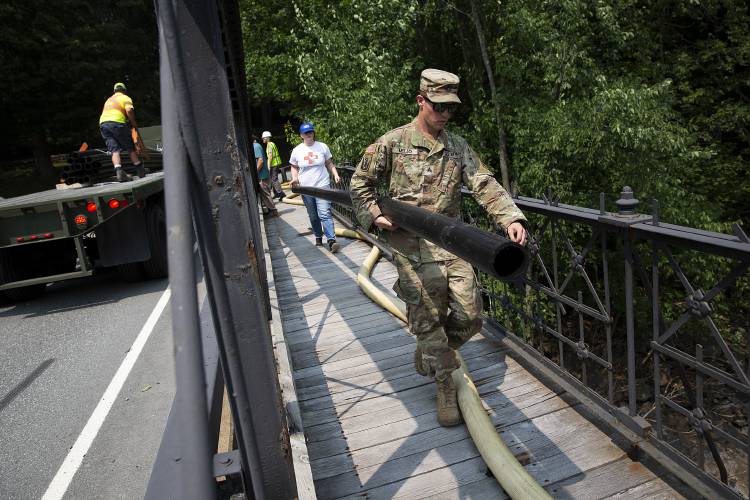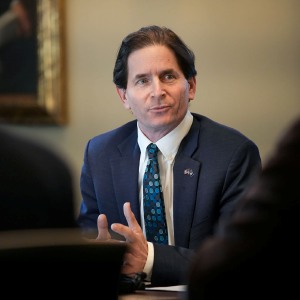Woodstock Aqueduct Co. urges town to take ownership of water utility

Army National Guard Sgt. Connor Mello carries a section of pipe across Elm Street Bridge with the help of Tess Malloy, who works in customer relations at the Woodstock Aqueduct Company, in Woodstock, Vt., on Monday, July 17, 2023. The potable water pipe will replace the fire hose connecting two fire hydrants across the river, allowing the town to access drinking water while the Woodstock Aqueduct Company works on a permanent solution to a broken pipe. (Valley News / Report For America - Alex Driehaus) Copyright Valley News. May not be reprinted or used online without permission. Send requests to permission@vnews.com. Alex Driehaus
| Published: 09-12-2023 5:11 PM |
WOODSTOCK — Residents in Woodstock were left without drinking water for more than a week after July’s floodwaters ripped through pipes maintained by the Woodstock Aqueduct Co.
Like much public infrastructure, water systems sit hidden in plain sight until there’s a problem. But issues regarding the Woodstock Aqueduct ownership, which is the largest privately owned public water system in Vermont, have been quietly simmering for over a century, Jireh Billings, the company’s president, said at a public meeting last month to discuss the company’s future.
With pipe damage from the flooding restored, attention has returned to other perennial problems that have left the water system out of compliance with state regulations. Woodstock Aqueduct doesn’t have enough money to finance the necessary repairs, Billings said. The owners, with longstanding ties in the town and village, are hoping to bring its fate to the negotiating table.
At the meeting, Billings spelled out three options for Woodstock Aqueduct’s future:
■The company raises the money to make repairs.
■The town of Woodstock buys them out.
■Or the company is sold to a private equity firm.
The meeting marked the first time Woodstock Aqueduct had ever publicly expressed an interest in a municipality taking ownership, Woodstock Municipal Manager Eric Duffy in a Tuesday interview.
Article continues after...
Yesterday's Most Read Articles
 Dartmouth moves swiftly to stymie demonstration, leads to 90 arrests
Dartmouth moves swiftly to stymie demonstration, leads to 90 arrests
 Claremont movie theater to close at end of May
Claremont movie theater to close at end of May
 Colby-Sawyer names interim president
Colby-Sawyer names interim president
 Kenyon: Dartmouth shows it has no patience for peaceful protest
Kenyon: Dartmouth shows it has no patience for peaceful protest
 Lebanon High senior comes to the aid of driver with health problem
Lebanon High senior comes to the aid of driver with health problem
“We are in the process of reviewing information that the aqueduct has provided,” he said. “Once more information is available, we’ll talk next steps.”
Woodstock Aqueduct’s long-term debt stands at $673,724, according to a balance sheet from December 2022 shared at the meeting.
The utility lost money in 2019 and 2020. In 2021 and 2022, it netted $13,293 and $45,414, respectively.
Another public meeting is scheduled for November to discuss the company’s financial status in greater depth, Duffy said.
Roughly half of the public water systems in Vermont are privately held. Woodstock Aqueduct is made up of 35 shareholders and five employees, and it services over 770 users — including Woodstock public schools, the Woodstock Resort Co., and Billings Farm and Museum. Billings, the company’s current president, is the son of Franklin S. Billings, a former federal judge, and member of the dynastic Woodstock family.
In addition to Woodstock Aqueduct’s customers, just under 100 fire hydrants also rely on water from the utility. Running afoul of state regulations, the water system can’t maintain adequate water pressure in about a quarter of its hydrants while the town’s wells are running.
“When they’re off and not supplying flow into the system, nearly all the hydrants fall below (pressure standards),” Craig Jewett said.
The issue is due to the layout of the water distribution infrastructure: The water storage tank is on the opposite side of town from Woodstock’s gravel packed wells, Jewett said at the meeting. An engineer who was representing Rutland-based Otter Creek Engineering, Jewett was hired by Woodstock Aqueduct to identify and recommend solutions to deficiencies in its system.
Woodstock Aqueduct “has made improvements over time to try to address (the pressure imbalance),” Jewett said. “This is not a new topic. This is a topic that has been going on hydrologically for the entire time the system (has existed). But publicly, in the last 15 years, it has really become a focus from a regulatory standpoint.”
Potential fixes include the construction of a new water storage tank, or select water main replacement, he said. The investments will need to be made over the next three to seven years, and it is too early to estimate how much they will cost.
The outdated and out-of-compliance conditions in the water system are “without a doubt” a chief limiter to Woodstock’s growth, Jewett said.
Still, of more immediate concern were the “do not drink” warnings posted in Woodstock in July, when its users in Woodstock village and part of West Woodstock were left offline for 10 days after the raging Ottauquechee River destroyed sections of the company’s distribution system. The resulting loss of pressure temporarily shuttered some restaurants and left users needing to nab FEMA-distributed bottled water.
A slew of water systems across Vermont were also disrupted by the flood event, but Woodstock was one of only two in the state that had to issue the more stringent warning.
While the turmoil this summer brought fresh focus to the operations of Woodstock Aqueduct, discussions about its structure are “not new,” said Charlie Kimbell, a former state legislator from Woodstock who moderated the meeting.
The company was incorporated by a handful of Woodstock businessmen in 1880. Over 140 years later, Billings is the fourth-generation of his family to steer the company, and more than half of the company’s stock remains in the Billings’ name.
Jireh Billings said stakeholders have long tried to hand off the company to the town. With the large, state-mandated repairs looming, there’s more urgency to act.
“My great-grandfather and his brother and several other businessmen went to the town to get them to build a public water system,” Billings said at the meeting. “After several attempts (that were not) successful, they formed this privately held company, and that’s how it remained.”
Over the years, successive generations of Billingses have approached the town with the same request.
“The main reason is I’m not going to be here forever,” he said. “The most important thing is that Woodstock controls its own water. That’s the most important thing to me and that was the most important thing to my ancestors.”
Woodstock Aqueduct has “not identified” a way to raise outside capital to finance the needed investments, Billings said. And selling it to a private third-party would “be the worst thing for all of us,” he said.
Still, if the municipality were to buy the company, resident Roger Logan has concerns.
“We need to be very clear on what the kind of financial burden is that’s going to be placed over and above other kinds of taxation and infrastructure that this town and village needs,” Logan said at the meeting.
In the meantime, the pitfalls of being a private company that functions like a public one are showing up on the balance sheet. Like the municipal systems, the company has to report to the Department of Environmental Conservation. But because Woodstock Aqueduct is privately-owned, Vermont’s Public Utilities Commission, or the PUC, has a say in its rates, and closely regulates any fundraising efforts.
“For the aqueduct company, that is a unique data point in this conversation, that there is an extra layer of regulatory oversight and regulatory control,” Jewett, the engineer, said. “That doesn’t exist for a majority of systems of similar size.”
Additionally, Woodstock Aqueduct is “effectively run as a nonprofit,” according to a slideshow presented at the meeting.
“In terms of buying or selling, it’s not a publicly-traded stock,” said former Woodstock Selectboard Chairman Tom Debevoise at the meeting.
Debevoise is a member of the Woodstock Aqueduct board, and inherited two shares in the company from his father.
“I’m trying to remember the last time the company made a dividend,” he said.
The PUC has already indicated to the company that its cash flow, as it stands now, won’t support additional debt, Kimbell said. As such, regulators could cut off the company’s ability to borrow. Woodstock Aqueduct, as a private entity, also isn’t eligible for federal or state infrastructure improvement grants.
There were 2,000 shares originally issued by the company, Billings said. “And that’s all that exists today. Those families bought all the inherited stock down. And so it’s quite like a genealogy tree. It just goes out in fingers from those families.”
“Our family wants this water system to be controlled by the town,” Billings said. “We will do everything we can to make sure it goes in that direction. But we also have financial issues that we have to work out.”
He made his public plea by calling on history.
“In the words of my father, because he used to go through this with the town many times, ‘make us an offer.’ ”
Frances Mize is a Report for America corps member. She can be reached at fmize@vnews.com or 603-727-3242.

 David Zuckerman is seeking reelection to lieutenant governor’s office
David Zuckerman is seeking reelection to lieutenant governor’s office Killington is the East’s largest ski resort. A developer wants to expand on that in a big way.
Killington is the East’s largest ski resort. A developer wants to expand on that in a big way. Norwich author and educator sees schools as a reflection of communities
Norwich author and educator sees schools as a reflection of communities
